文章信息
- 元云岗, 康嘉杰, 岳文, 付志强, 朱丽娜, 佘丁顺, 王成彪
- YUAN Yun-gang, KANG Jia-jie, YUE Wen, FU Zhi-qiang, ZHU Li-na, SHE Ding-shun, WANG Cheng-biao
- 不同温度下等离子渗氮后TC4钛合金的摩擦磨损性能
- Tribological properties of TC4 titanium alloy treated by plasma nitriding at different temperatures
- 材料工程, 2020, 48(2): 156-162
- Journal of Materials Engineering, 2020, 48(2): 156-162.
- http://dx.doi.org/10.11868/j.issn.1001-4381.2018.000367
-
文章历史
- 收稿日期: 2018-04-02
- 修订日期: 2019-07-18
2. 中国地质大学(北京) 郑州研究院, 郑州 451283;
3. 中国地质科学院 郑州矿产综合利用研究所, 郑州 450006
2. Zhengzhou Institute, China University of Geosciences(Beijing), Zhengzhou 451283, China;
3. Zhengzhou Institute of Multipurpose Utilization of Mineral Resources, Chinese Academy of Geological Sciences, Zhengzhou 450006, China
TC4钛合金由于密度小、比强度高、耐蚀耐热好等优异性能,被广泛应用于航空、生物、建筑等领域[1-3]。紧固件(如螺栓、螺母、铆钉等)是钛合金应用于航天领域的一个重要方面。但是,由于钛合金硬度低、塑性高、滑动摩擦因数大、导热系数小,使得钛合金螺栓的螺纹表面具有很强的黏结性,限制了其应用[4-6]。表面完整性对材料性能有着广泛的影响。它包括表面形貌、表面残余应力、显微结构和显微硬度四大类,而显微结构的研究最为广泛[7]。运用表面完整性理论,表面改性技术成为一种改善钛合金硬度和耐磨性的有效方法,如喷丸,磁控溅射,离子注入,物理、化学气相沉积,等离子渗氮等[8-11]。高玉魁[12-13]采用脉冲电子束对TA15钛合金和TA2钛合金进行表面处理,并系统分析了脉冲电子能量密度(Es)、脉冲持续时间(λ)和脉冲照射次数(N)对试样显微结构、表面粗糙度和纳米硬度的影响。同时发现热应力引起的位错及细亚晶粒的形成是改善试样显微硬度的主要原因,且耐磨性及疲劳性能也得到了改善。而喷丸处理仅使晶粒细化,硬度提高不明显[14-16]。磁控溅射、离子注入及气相沉积技术制备的膜层较薄,膜基结合力较弱[17-20]。与其他表面改性技术相比,等离子渗氮工艺通过辉光放电,氮离子与表面基体产生反应生成氮化物,氮原子通过热扩散向基体内部扩散,在材料表面形成Ti2N和TiN[21-23]。等离子渗氮工艺制备的氮化层膜基结合力好,硬度大幅提高,改善了材料的耐磨性[24-26]。因此,等离子渗氮工艺成为人们研究的一个热点。
目前,大量研究人员已采用等离子渗氮工艺对钛及钛合金进行处理,通过在其表面形成氮化物层,进而提高其表面硬度和耐磨性。例如郭纯等[27]和She等[28]研究了TC4钛合金及工业纯钛的真空摩擦学性能,经等离子渗氮后试样的表面硬度提高,真空摩擦学性能得到改善。佟宇等[29-30]证明了纯钛铸件经等离子渗氮处理(渗氮温度低于750 ℃)后的硬度和耐磨性显著提升,在人工唾液中的耐腐蚀性也明显增加,提高了义齿钛支架的性能和使用寿命。Ali等[31]和Yilabs等[32]发现,等离子渗氮(渗氮温度低于700 ℃)后的试样与未处理试样相比,硬度得到了提高,改善了耐磨性。然而,上述研究中渗氮温度主要集中在750 ℃以下,获得的渗氮层厚度较薄,不利于氮化物涂层性能的发挥。因此,有必要对钛合金的高温渗氮进行研究。本工作基于改造后的等离子渗氮设备(LDM 1-100型等离子渗氮炉),以650,700,750,800,850 ℃和900 ℃为渗氮温度,保温时间10 h,研究不同温度渗氮后TC4钛合金的组织性能,并揭示其磨损机制,得到最优的等离子渗氮温度,为钛合金的高温等离子渗氮处理提供理论依据及工程指导。
1 实验材料与方法 1.1 实验材料采用TC4钛合金板材作为研究对象,其表面硬度约为360HV0.05。TC4钛合金的化学成分见表 1。实验前试样抛光至镜面,并用丙酮清洗。
| Al | V | Fe | C | N | H | O | Ti |
| 6 | 4 | 0.3 | 0.1 | 0.05 | 0.015 | 0.2 | Bal |
利用LDM 1-100型渗氮炉对TC4钛合金试样进行等离子渗氮处理。在渗氮过程中,试样放置于阴极盘上,炉壁为阳极。采用红外线温度计和热电偶来实现渗氮温度的实时监测,实验温度选用650,700,750,800,850 ℃和900 ℃。渗氮前,通过机械泵将炉内气压抽至极限真空,确保漏气率低于8 Pa/h后,通入一定量的NH3使压强升至70~90 Pa,电压升高至650~850 V。清洗样品,观察炉内打弧现象,待打弧消失后增大NH3流量并打开机械泵,使炉内压强缓慢升高。待温度升高到指定温度后保温10 h。渗氮结束后,样品随炉冷却。根据渗氮温度差异,离子渗氮后试样被标记为650PN,700PN,750PN,800PN,850PN和900PN。
1.3 试样形貌与性能表征渗氮层的相组成由X射线衍射仪(XRD)表征,使用CuKα靶源(波长0.15406 nm)和连续扫描模式,扫描范围为35°~80°,扫描速率为0.04 (°)/s。TC4钛合金试样的截面抛光后在Kroll’s腐蚀液(由6 mL HNO3,3 mL HF和100 mL H2O配制)下浸蚀10~30 s,清洗晾干后在BX51M型光学显微镜下进行观察。选用Xort型扫描电子显微镜(SEM)观察渗氮试样的表面形貌及磨痕形貌,利用Nano-Map-D 3D型白光表面形貌三维仪观测其表面粗糙度和三维形貌。
用MH-6型显微硬度仪测量不同温度渗氮后试样的截面显微硬度。载荷0.49 N,保载时间15 s,每一横截面深度测3次,取平均值。利用MFT-4000型划痕仪进行划痕实验,以测试试样表面渗氮层的承载能力。加载速率为100 N/min,终止载荷为50 N。
1.4 摩擦学实验利用CETR UMT-3型多功能摩擦磨损试验机对不同温度渗氮TC4钛合金试样的摩擦学性能进行测试。实验过程中,采用“球/盘”往复模式,摩擦载荷为1,3,5 N,频率5 Hz,对磨球为Si3N4,实验时间30 min,相对滑动速率为0.025 m/s。实验结束后利用Nano-Map-D 3D型白光表面三维形貌仪表征磨痕的三维形貌,利用Xort型扫描电子显微镜(SEM)观察渗氮试样的磨痕微观形貌以分析其磨损机制。
2 结果与讨论 2.1 微观形貌利用SEM观察不同温度渗氮后TC4钛合金试样的表面微观形貌,如图 1所示。由图 1可见,随着温度的升高,氮化物颗粒尺寸明显增大。650PN试样表面氮化物稀少,从750PN开始,氮化物基本覆盖整个基体表面,并随着温度的升高,氮化物颗粒尺寸逐渐增大。较高的渗氮温度使得氨气分解率提高,促进氮化物晶粒的成核及长大。

|
图 1 不同温度渗氮后TC4试样的表面微观形貌 (a)650PN;(b)700PN;(c)750PN;(d)800PN;(e)850PN;(f)900PN Fig. 1 Surface morphologies of TC4 specimens under different nitriding temperatures (a)650PN; (b)700PN; (c)750PN; (d)800PN; (e)850PN; (f)900PN |
图 2为不同温度渗氮后TC4钛合金试样的表面粗糙度。可见,随着温度的升高,N原子的扩散率升高,化学反应更易进行,氮化物含量和晶粒尺寸逐渐增大,进而导致表面粗糙度增加,当氮化温度为850 ℃时,表面粗糙度急剧增加。

|
图 2 不同温度渗氮后TC4试样的表面粗糙度 Fig. 2 Surface roughness of TC4 specimens under different nitriding temperatures |
图 3为不同温度渗氮后TC4钛合金试样的表面三维形貌。由图 3(e)和3(f)可见,在850 ℃和900 ℃下进行渗氮处理后,TC4钛合金试样表面出现大量的尖锐凸峰,从而导致粗糙度的急剧增加。
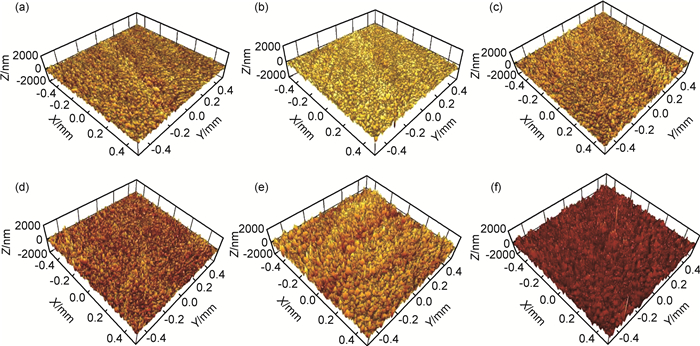
|
图 3 不同温度渗氮后TC4试样的表面三维形貌 (a)650PN;(b)700PN;(c)750PN;(d)800PN;(e)850PN;(f)900PN Fig. 3 3D topographies of TC4 specimens under different nitriding temperatures (a)650PN; (b)700PN; (c)750PN; (d)800PN; (e)850PN; (f)900PN |
图 4为不同渗氮温度下TC4钛合金试样的横截面微观形貌。可见随着温度的升高,N原子的扩散率增大,渗氮层及氮化物层厚度明显增加。渗氮层厚度从700PN试样的约40 μm增加到900PN试样的140 μm。650PN和700PN试样几乎看不到氮化物层;从750PN开始,可以看到明显的氮化物层,厚度约为3 μm;900PN时,氮化物层厚度达到了11 μm。随着温度的升高,在900PN时发生晶粒粗化,且成板条状β-Ti组织析出。
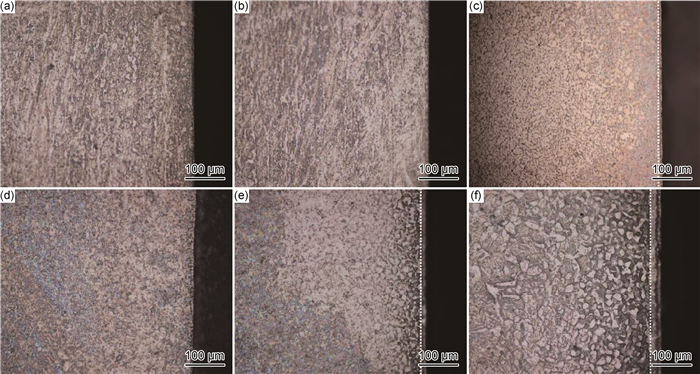
|
图 4 不同温度渗氮后TC4试样的截面微观形貌 (a)650PN;(b)700PN;(c)750PN;(d)800PN;(e)850PN;(f)900PN Fig. 4 Cross-sectional morphologies of TC4 specimens under different nitriding temperatures (a)650PN; (b)700PN; (c)750PN; (d)800PN; (e)850PN; (f)900PN |
图 5为不同温度渗氮后TC4钛合金试样表面的XRD谱图。可见,未处理TC4钛合金试样表面主要由α-Ti和β-Ti相组成。随着渗氮温度的升高,α-Ti和β-Ti衍射峰强度逐渐降低,而氮化物(δ-TiN和ε-Ti2N)的衍射峰不断增强。当渗氮温度高于800 ℃以后,几乎不存在α-Ti相。当渗氮温度高于650 ℃时,氮化物开始形成,随着渗氮温度的升高,TiN和Ti2N衍射峰强度显著增强。表明高温渗氮有利于TC4合金表面大量形成氮化物,进而提高其表面力学性能和耐磨性能。
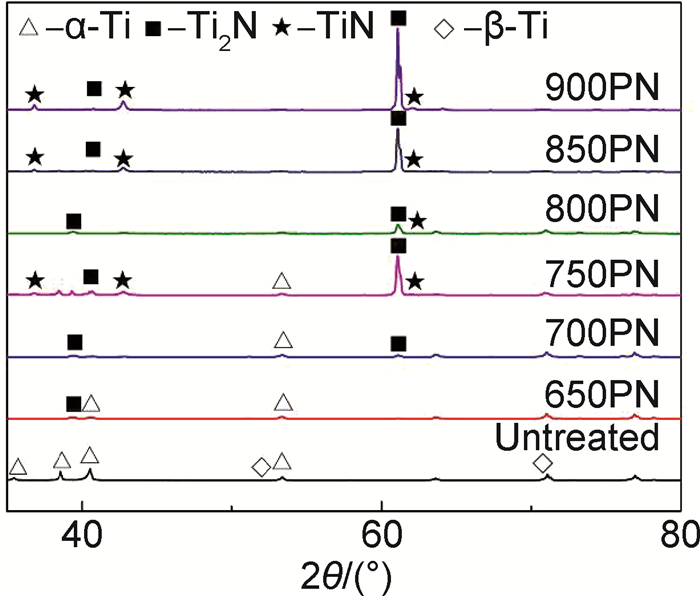
|
图 5 不同渗氮温度下TC4试样的X射线衍射谱图 Fig. 5 XRD patterns of TC4 specimens under different nitriding temperatures |
图 6为不同温度渗氮后TC4钛合金试样的截面显微硬度分布图。可见,与未处理TC4钛合金基体显微硬度(360HV0.05)相比,渗氮处理后其表面显微硬度得到明显提高,并以每50 ℃硬度约提高200HV0.05的幅度增加。当渗氮温度为900 ℃时,显微硬度约为1400HV0.05。此外,沿基体方向的显微硬度呈梯度降低趋势,并逐渐接近360HV0.05。可见硬度的提高取决于硬质氮化物的形成和氮化物层厚度,氮化物层厚度越大,其力学性能提高越显著。

|
图 6 不同渗氮温度下TC4试样的截面显微硬度随深度分布 Fig. 6 Cross-sectional micro-hardness versus depth of TC4 specimens under different nitriding temperatures |
图 7为不同温度渗氮后TC4钛合金试样表面的划痕形貌。可见,经过渗氮处理后,形成裂纹的临界载荷明显增加,当渗氮温度低于750 ℃时,其萌生裂纹的临界载荷约为33 N。这是由于硬质氮化层有利于缓解划痕过程中的应力集中,阻碍裂纹的形成。随着渗氮温度的升高,氮化物层厚度逐渐增加,使得萌生裂纹的临界载荷进一步增加,850 ℃时达到49 N左右,随后降低到43 N左右(900 ℃),这可能是由于晶粒粗化导致的结果。
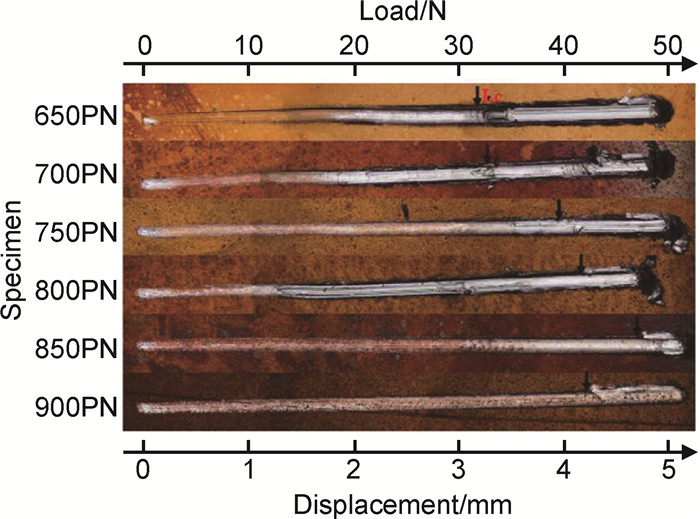
|
图 7 不同渗氮温度下TC4试样表面划痕形貌 Fig. 7 Scratch morphology of TC4 specimens under different nitriding temperatures |
图 8为不同温度渗氮后TC4钛合金试样的平均摩擦因数。由于氮化物硬质相(TiN和Ti2N)的出现,表面粗糙度增加,渗氮后试样的平均摩擦因数均比未处理试样的摩擦因数高。850 ℃下的试样平均摩擦因数较其他温度下的小,原因在于,在850 ℃下渗氮试样的渗氮层结合强度高,摩擦磨损过程中氮化层不易脱落成为磨屑。900PN的平均摩擦因数较高,原因在于,晶粒尺寸较大,有板条状β-Ti组织析出,且硬脆相氮化物的含量较高(图 5)。
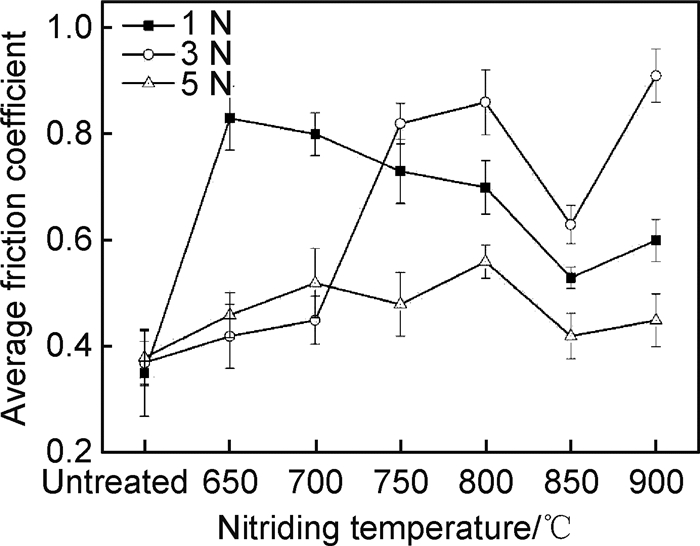
|
图 8 不同渗氮温度下TC4试样的平均摩擦因数 Fig. 8 Average friction coefficient of TC4 specimens under different nitriding temperatures |
图 9为不同温度渗氮后TC4钛合金试样的磨损体积。可见,经不同温度渗氮后,在某一固定载荷下,未处理试样的磨损体积最大,约为0.031 mm3(1 N),0.047 mm3(3 N)和0.082 mm3(5 N);850PN磨损体积最小,为3.63×10-4 mm3(1 N),0.0014 mm3(3 N)和0.051 mm3(5 N)。随着载荷增加,接触区域的接触应力增大,渗氮层在较短的时间内磨损,导致对磨球与基体直接接触,因此磨损量随载荷增加而增大。850PN试样由于表面渗氮层较为致密,力学性能良好,因此在1 N和3 N载荷下表现出优异的耐磨性能。
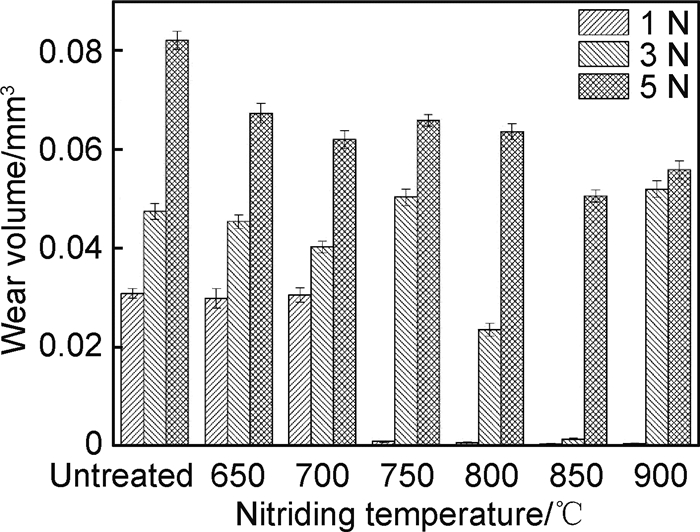
|
图 9 不同渗氮温度下TC4试样的磨损量 Fig. 9 Wear volume of TC4 specimens under different nitriding temperatures |
(1) 经等离子渗氮后,TC4钛合金的表面形成了硬质氮化物相(δ-TiN和ε-Ti2N),使得其表面硬度明显提升。随着渗氮温度的升高,氮化物含量增加,硬度也随之升高。当渗氮温度为900 ℃时,TC4钛合金的表面显微硬度达到1318HV0.05,是未处理试样的4倍。
(2) 当渗氮温度小于750 ℃时,渗氮后TC4钛合金试样的临界载荷较小。其原因在于薄的渗氮层以及硬脆相(如Ti2N和TiN)的形成。随着渗氮温度的升高渗氮层变厚,使得850 ℃和900 ℃渗氮后TC4钛合金的渗氮层有比较好的承载能力。
(3) 850 ℃离子渗氮后TC4钛合金表现出最好的耐磨性能,与TC4钛合金基体相比,其耐磨性提升了98%(1 N),97%(3 N)和38%(5 N)。
| [1] |
王欢, 赵永庆, 辛社伟, 等. 高强韧钛合金热加工技术与显微组织[J]. 航空材料学报, 2018, 38(4): 56-63. WANG H, ZHAO Y Q, XIN S W, et al. Review thermomechanical processing and microstructure of high strength-toughness titanium alloy[J]. Journal of Aeronautical Materials, 2018, 38(4): 56-63. |
| [2] |
季英萍, 吴素君. 应力比对Ti-6Al-2Zr-1Mo-1V合金疲劳裂纹扩展行为的影响[J]. 航空材料学报, 2018, 38(3): 72-76. JI Y P, WU S J. Effect of stress ratio on fatigue crack growth behavior of Ti-6Al-2Zr-1Mo-1V alloy[J]. Journal of Aeronautical Materials, 2018, 38(3): 72-76. |
| [3] |
陈孝文, 李仁仆, 张德芬, 等. 氧化时间对钛合金钻杆微弧氧化膜层结构和性能的影响[J]. 材料导报, 2017, 31(增刊1): 489-492, 518. CHEN X W, LI R P, ZHANG D F, et al. Effect of oxidation time on structure and properties of micro-arc oxidation film on titanium alloy drill pipe[J]. Materials Review, 2017, 31(Suppl 1): 489-492, 518. |
| [4] |
HUANG H M, HSIEH S C, TENG N C, et al. Biological surface modification of titanium surfaces using glow discharge plasma[J]. Medical & Biological Engineering & Computing, 2011, 49(6): 701-706. |
| [5] |
梁健, 岳文, 孙建华, 等. 超声波冷锻与阳极氧化处理铝合金钻杆摩擦学性能研究[J]. 地质与勘探, 2016, 52(3): 576-583. LIANG J, YUE W, SUN J H, et al. Study on tribological properties of aluminum drill pipes under ultrasonic cold forging and anodic oxidation treatment[J]. Geology and Exploration, 2016, 52(3): 576-583. |
| [6] |
温诗铸, 黄平. 摩擦学原理[M]. 第3版. 北京: 清华大学出版社, 2012: 420. WEN S Z, HUANG P. Principles of tribology[M]. 3rd ed. Beijing: Tsinghua University Press, 2012: 420. |
| [7] |
高玉魁. 表面完整性理论与应用[M]. 北京: 化学工业出版社, 2014: 1-2. GAO Y K. Surface integrity theory and application[M]. Beijing: Chemical Industry Press, 2014: 1-2. |
| [8] |
ANIOLEK K, KUPKA M, BARYLSKI A. Sliding wear resistance of oxide layers formed on a titanium surface during thermal oxidation[J]. Wear, 2016, 356/357: 23-29. DOI:10.1016/j.wear.2016.03.007 |
| [9] |
杨闯, 彭晓东, 刘静, 等. TC4钛合金低压真空氮化改性层的制备与性能[J]. 材料工程, 2015, 43(3): 78-82. YANG C, PENG X D, LIU J, et al. Preparation and property of low pressure vacuum nitriding modified layer on TC4 titanium alloy[J]. Journal of Materials Engineering, 2015, 43(3): 78-82. |
| [10] |
QUAN H X, GAO S S, ZHU M H, et al. Comparison of the torsional fretting behavior of three porous titanium coatings for biomedical applications[J]. Tribology International, 2015, 92: 29-37. DOI:10.1016/j.triboint.2015.05.017 |
| [11] |
WANG S, MA Z, LIAO Z H, et al. Study on improved tribological properties by alloying copper to CP-Ti and Ti-6Al-4V alloy[J]. Materials Science & Engineering C-Materials for Biological Applications, 2015, 57: 123-132. |
| [12] |
GAO Y K. Influence of pulsed electron beam treatment on microstructure and properties of TA15 titanium alloy[J]. Applied Surface Science, 2013, 264: 633-635. DOI:10.1016/j.apsusc.2012.10.083 |
| [13] |
GAO Y K. Surface modification of TA2 pure titanium by low energy high current pulsed electron beam treatments[J]. Applied Surface Science, 2011, 257(17): 7455-7460. DOI:10.1016/j.apsusc.2011.03.005 |
| [14] |
GUO F A, TRANNOY N, LU J. Microstructural analysis by scanning thermal microscopy of a nanocrystalline Fe surface induced by ultrasonic shot peening[J]. Superlattices & Microstructures, 2004, 35(3/6): 445-453. |
| [15] |
张晓化, 刘道新. 电火花表面强化与喷丸复合处理对Ti811合金高温微动疲劳性能的影响[J]. 材料工程, 2006(9): 31-35, 41. ZHANG X H, LIU D X. Effects of electrospark surface strengthening and shot peening on fretting fatigue of Ti811 alloy at elevated temperature[J]. Journal of Materials engineering, 2006(9): 31-35, 41. DOI:10.3969/j.issn.1001-4381.2006.09.009 |
| [16] |
LIU Y G, LI M Q, LIU H J. Surface nano crystallization and gradient structure developed in the bulk TC4 alloy processed by shot peening[J]. Journal of Alloys & Compounds, 2016, 685: 186-193. |
| [17] |
屠振密, 朱永明, 李宁, 等. 钛及钛合金表面处理技术的应用及发展[J]. 表面技术, 2009, 38(6): 76-78, 86. TU Z M, ZHU Y M, LI N, et al. Applications and advances on surface treatment for titanium and titanium alloy[J]. Surface Technology, 2009, 38(6): 76-78, 86. DOI:10.3969/j.issn.1001-3660.2009.06.026 |
| [18] |
刘洪喜, 汤宝寅, 王浪平, 等. 钛合金的等离子体浸没离子注入表面强化处理[J]. 稀有金属材料与工程, 2005, 34(8): 1318-1321. LIU H X, TANG B Y, WANG L P, et al. Improvement on surface properties of titanium alloy by plasma immersion ion implantation technique[J]. Rare Metal Materials and Engineering, 2005, 34(8): 1318-1321. DOI:10.3321/j.issn:1002-185X.2005.08.035 |
| [19] |
NOLAN D, HUANG S W, LESKOVSEK V, et al. Sliding wear of titanium nitride thin films deposited on Ti-6Al-4V alloy by PVD and plasma nitriding processes[J]. Surface & Coatings Technology, 2006, 200(20/21): 5698-5705. |
| [20] |
张慧桥, 黄晓波, 田伟红, 等. Ti6Al4V表面Ti-Cu-N纳米薄膜溅射沉积及其抗菌性能研究[J]. 表面技术, 2014, 43(4): 1-5. ZHANG H Q, HUANG X B, TIAN W H, et al. Antibacterial properties of Ti-Cu-N composite films deposited on Ti6Al4V alloy by magnetron sputtering[J]. Surface Technology, 2014, 43(4): 1-5. |
| [21] |
MORITA T, UEHIGASHI N, KAGAYA C. Improvement of fatigue strength of Ti-6Al-4V alloy by hybrid surface treatment composed of plasma nitriding and fine-particle bombarding[J]. Materials Transactions, 2013, 54(9): 1719-1724. DOI:10.2320/matertrans.M2013228 |
| [22] |
VASCONCELLOS M A Z, LIMA S C, HINRICHS R. Hardness evaluation, stoichiometry and grain size of titanium nitride films obtained with plasma nitriding on Ti-6Al-4V samples[J]. Materia-Rio de Janeiro, 2010, 15(2): 299-302. |
| [23] |
YETIM A F, YILDIZ F, VANGOLU Y, et al. Several plasma diffusion processes for improving wear properties of Ti6Al4V alloy[J]. Wear, 2009, 267(12): 2179-2185. DOI:10.1016/j.wear.2009.04.005 |
| [24] |
RAHMAN M, HASHMI M S J. Saddle field fast atom beam source:a new low pressure plasma nitriding method for a alloy Ti-6Al-4V[J]. Thin Solid Films, 2006, 515(1): 129-134. DOI:10.1016/j.tsf.2005.12.050 |
| [25] |
NIU R L, LI J L, WANG Y X, et al. Structure and tribological behavior of GLCH/nitride coupled coatings on Ti6Al4V by nitriding and magnetron sputtering[J]. Diamond & Related Materials, 2016, 64: 70-79. |
| [26] |
FAN A L, ZHANG H Q, MA Y, et al. Bacteria adherence properties of nitrided layer on Ti6Al4V by the plasma nitriding technique[J]. Journal of Wuhan University of Technology-Mater Sci Ed, 2013, 28(6): 1223-1226. DOI:10.1007/s11595-013-0849-4 |
| [27] |
郭纯, 陈建敏, 周健松, 等. Ti-6AI-4V合金在模拟空间环境下的摩擦学性能[J]. 材料科学与工程学报, 2012, 30(6): 822-826. GUO C, CHEN J M, ZHOU J S, et al. Tribological properties of Ti-6Al-4V in simulated space environments[J]. Journal of Materials Science and Engineering, 2012, 30(6): 822-826. |
| [28] |
SHE D S, YUE W, FU Z Q, et al. Effects of nitriding temperature on microstructures and vacuum tribological properties of plasma-nitrided titanium[J]. Surface & Coatings Technology, 2015, 264: 32-40. |
| [29] |
佟宇, 郭天文, 洪春福, 等. 辉光等离子渗氮对纯钛铸件表面性能的影响[J]. 真空科学与技术学报, 2010, 30(1): 76-79. TONG Y, GUO T W, HONG C F, et al. Plasma nitridation and mechanical properties of pure titanium casts[J]. Chinese Journal of Vacuum Science and Technology, 2010, 30(1): 76-79. DOI:10.3969/j.issn.1672-7126.2010.01.16 |
| [30] |
佟宇, 郭天文, 王菁, 等. 等离子渗氮、离子镀TiN复合处理对纯钛铸件硬度及耐磨性的影响[J]. 真空科学与技术学报, 2011, 31(4): 402-405. TONG Y, GUO T W, WANG J, et al. Surface modification of cast titanium used as denture framework[J]. Chinese Journal of Vacuum Science and Technology, 2011, 31(4): 402-405. DOI:10.3969/j.issn.1672-7126.2011.04.05 |
| [31] |
ALI M M, RAMAN S G S, PATHAK S D, et al. Influence of plasma nitriding on fretting wear behaviour of Ti-6Al-4V[J]. Tribology International, 2010, 43(1/2): 152-160. |
| [32] |
YILBAS B S, SAHINA Z, AlGARNIA Z, et al. Plasma nitriding of Ti-6Al-4V alloy to improve some tribological properties[J]. Surface & Coatings Technology, 1996, 80(3): 287-292. |
 2020, Vol. 48
2020, Vol. 48


